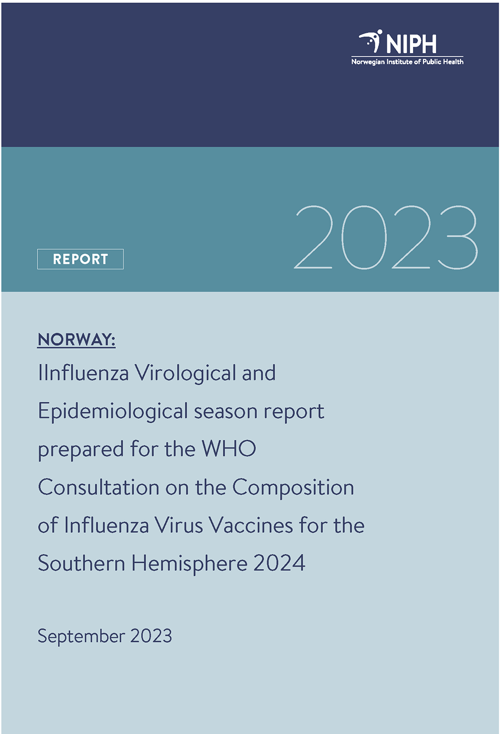Influenza Virological and Epidemiological season report prepared for the WHO Consultation on the Composition of Influenza Virus Vaccines for the Southern Hemisphere 2024
Report
|Published
The current season started early with outbreak threshold of 10 % positives in week 48 (sentinel)/week 49 (comprehensive) and had a sharp first peak in weeks 51-52/2022 with 46 % positives in the sentinel and 25 % positives in the comprehensive surveillance. The positivity rate fell markedly in the following few weeks before it recovered and went through two smaller peaks in weeks 6 and 12, respectively. After this, the numbers declined gradually, falling below 10 % positives in overall testing in week 15 and in sentinel testing in week 18. The positivity rate has been very low (below 1%) since midsummer but with sporadic detections in every week.
Key message
- The preceding 2021-2022-influenza season developed unusually late, only after the distancing measures against COVID-19 were lifted in February, and at a time when the Omicron-variant driven main pandemic wave was on its decline. The influenza outbreak peaked around week 15, was of low-to medium magnitude, and influenza A(H3N2) viruses in the 3C.2a1b.2a.2 group predominated.
- Seroprevalence against A/Victoria/2570/2019(H1N1) was at a moderate level in sera collected in August 2022. However, there was significantly less antibodies against the A/Norway/25089/2022 strain, which became a prominent subvariant during the H1 outbreak seen in early winter. Seroprevalence against A/Darwin/9/2021 (H3N2) was low in the general population (22 %), although higher in the age groups 5-14 and 15-24 years potentially due to late H3N2-epidemic in spring 2022. Seroprevalence against recent B/Victoria-lineage virus was at a low level, especially in the younger age groups, suggesting
a high degree of susceptibility. - The current season started early with outbreak threshold of 10 % positives in week 48 (sentinel)/week 49 (comprehensive) and had a sharp first peak in weeks 51-52/2022 with 46 % positives in the sentinel and 25 % positives in the comprehensive surveillance. The positivity rate fell markedly in the following few weeks before it recovered and went through two smaller peaks in weeks 6 and 12, respectively. After this, the numbers declined gradually, falling below 10 % positives in overall testing in week 15 and in sentinel testing in week 18. The positivity rate has been very low (below 1%) since midsummer but with sporadic detections in every week.
- Influenza A(H1N1) viruses predominated in the first and largest peak around New Year. With subsequently declining numbers, the frequencies of H1N1 and H3N2 also became more even. Influenza B/Victoria lineage viruses started to rise after New Year, passed influenza A in week 8, and were predominant in the last wave that peaked in week 12. Since midsummer, influenza A viruses have again been in majority among the few detections with a large proportion being H1N1. All circulating influenza B viruses that have
been tested for lineage have belonged to the B/Victoria/2/1987 lineage. - The age group representing school-age children has had the highest proportion of influenza positives throughout the period and has shown rising numbers earlier than the other age groups.
- The proportion of influenza-like illness (ILI) consultations in primary health care gradually increased from week 40/2022, with a rapid increase from week 48/2022, crossing the epidemic threshold the week after. It peaked in week 52/2022, several weeks earlier than normal. After a steep decrease until week 3/2023, the decrease was more gradual, including two minor peaks corresponding to the pattern in the virological surveillance. It crossed below the epidemic threshold in week 14/2023, resulting in a 14-week-long
influenza outbreak, two weeks longer than average, before decreasing further down toward and through the summer. - The numbers of hospitalisations and ICU admissions with influenza began to increase around week 46-2022, reaching a peak in week 52-2022. As of week 34-2023, 5462 hospital admissions and 193 ICU admissions have been reported, clearly exceeding numbers reported for the preceding season 2021-2022. The weekly number of influenza-associated deaths peaked during weeks 52-2022 – 2-2023, coinciding with the highest rate of all-cause mortality in Norway since 2017.
- 30% (1378/4546) of all influenza positive samples received for surveillance have been whole genome sequenced. Both the H1N1 A/Sydney/5/2021 6B.1A.5a.2 lineage and its A/Norway/25089/2022 6B.1A.5a.2.1 sublineage with the HA P137S substitution have been circulating, but by mid-season the A/Sydney-lineage viruses predominated with several separate clusters. The H3N2 viruses are all categorized as 3C.2a.1b.2a.2 belonging to the A/Slovenia/8720/2022 group of viruses with the R299K substitution. All influenza B viruses sequenced were B/Victoria lineage, belonging to the B/Austria/1359417/2021 clade, but several subgroups were detected with some mutation differences and dominated the late season.
- Vaccination coverage among risk groups younger than 65 years and health care workers decreased compared to the 2021/2022 season. The coverage rate for individuals above 65 years was 64 %, which is at the same level as last season. The number of distributed doses decreased by 9 % compared to the 2021/22 season. 1.2 million doses intended for use in risk groups and health care workers were distributed.
- Highly pathogenic avian influenza viruses (H5N1, H5N5) belonging to clade 2.3.4.4b continued to be detected in wild birds in Norway. During autumn 2022 there were two outbreaks of H5N1 in commercial poultry flocks. In the summer of 2023, there was a mass mortality event among seagulls (particularly black-legged kittiwakes) along the northern coastline of Norway, caused by HPAI H5N1. This virus was also detected in a young red fox found dead in the same area. No human cases have been detected, and the risk of human infection has been assessed as very low.

